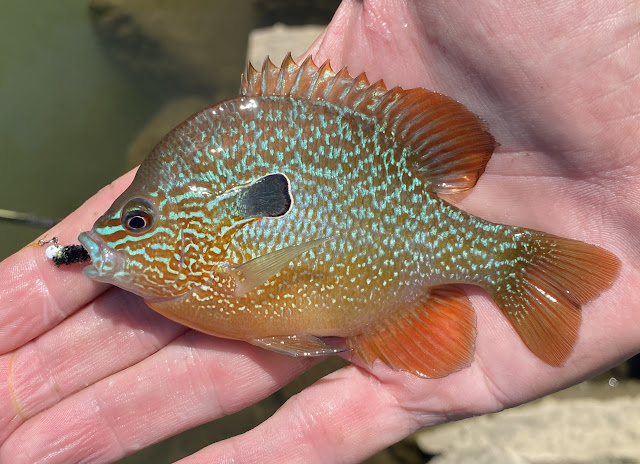***I haven't shared much regarding techniques for quit a while, my recent posts being more about the fish with which I am so enamored. I'm going to start sharing more specifically what I've learned for the various species I've caught.
We all know fish in different waters can behave differently and have different preferences. But I think overall this will give folks who want to try for certain species more info that can hopefully get them started off on the right foot, rather than going blindly. We can all shorten our personal learning curve by first learning from the experience of others.***
This blog post is about Longear Sunfish.
 |
| Longear Sunfish on fly |
Longear Sunfish have been, or are being, broken out into several species and subspecies. You are welcome to look up information on that if interested. I'm just going to group them together under "Longear Sunfish".
Longear Sunfish inhabit much of the east-central U.S. west of the Appalachians, from the Great Lakes region, Ohio River system, and lower Mississippi River system (south of Iowa), plus southern states from Texas to Alabama.
They most often seem to prefer reasonably clear rocky streams and creeks.
They will eat terrestrial bugs that fall onto the water, aquatic nymphs, worms, small fish, and small crustaceans. So, they will eat from the surface to the bottom. Its fun to catch them on topwater. They are really aggressive fish and will strike larger flies and lures, but their mouths are sort of small, so its probably best to use a hook size of #8 or smaller, and a #10 or #12 might be best.
I catch them most often during the warmer months, from mid-Spring to mid-Fall. Outside of their spawning season, they can be somewhat drab colored, but during the spawn...they are definitely one of the most beautifully colored of the sunfishes.
They seem to like a gravelly bottom, and they can often be found out in the open over a flat bottom in a medium current, or near structures such as rocks and wood.
If you can see them, you can often put a fly close enough to them to elicit a strike, but they can certainly be caught by fan-casting or blind casting an area.
Again, foam topwater bugs are a fun way to catch them, but if they don't want to eat on top, you can usually coax them to eat subsurface. If your fly is the right size, and looks alive, they will hit it.
Dapping a small microjig in likely areas or to specific visible fish is a consistently successful technique. The microjigs I use most for them are from 1/100th oz to 1/64th oz, #10 hook. Color doesn't seem to matter at all.
 |
| These microjigs are tied on #12 or #14 custom jigheads, and have caught plenty of Longear Sunfish for me. |
They don't get particularly big, usually, and they fight well enough for their size. Longear Sunfish can be enjoyed on 3wt-5wt fly rods. I use a weight forward floating line, and tippet should be 2lb-8lb Fluorocarbon.
Wading creeks or medium- to small- streams during the summer is a GREAT way to spend time in nature and catch these gorgeous sunfish.
Longear Sunfish are very beautiful, aggressive, and fun. I really enjoy catching them on flies. They are a native fish that needs to be appreciated. Do some research, find some fish near you, and get after them! Good luck!
Here's some pics of Longear Sunfish I've caught while flyfishing:
































































